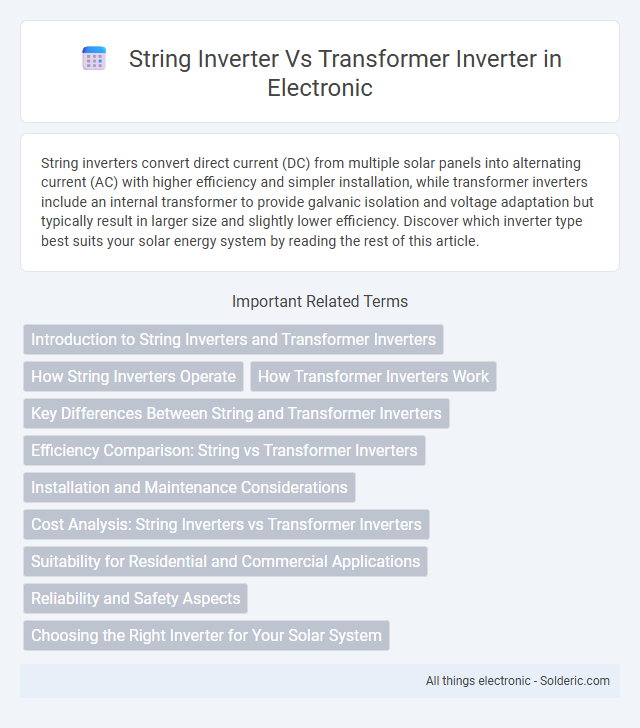String inverters convert direct current (DC) from multiple solar panels into alternating current (AC) with higher efficiency and simpler installation, while transformer inverters include an internal transformer to provide galvanic isolation and voltage adaptation but typically result in larger size and slightly lower efficiency. Discover which inverter type best suits your solar energy system by reading the rest of this article.
Comparison Table
| Feature | String Inverter | Transformer Inverter |
|---|---|---|
| Technology | Converts DC from solar panel strings directly to AC. | Uses transformers to step up/down voltage during DC to AC conversion. |
| Efficiency | High efficiency (95-98%) due to transformerless design. | Lower efficiency (90-95%) due to transformer losses. |
| Weight & Size | Lighter and compact design. | Heavier and bulkier because of transformer units. |
| Cost | Typically more expensive upfront but better ROI. | Generally cheaper initial cost but lower efficiency. |
| Safety & Isolation | Limited galvanic isolation; requires additional measures. | Built-in galvanic isolation enhances safety. |
| Durability | Less robust in harsh environments. | More robust and tolerant to variations. |
| Applications | Residential and commercial solar systems. | Industrial settings requiring electrical isolation. |
Introduction to String Inverters and Transformer Inverters
String inverters convert direct current (DC) from solar panels into alternating current (AC) without using transformers, offering higher efficiency and lighter weight, ideal for residential systems. Transformer inverters include transformers to adjust voltage levels and provide electrical isolation, enhancing safety and compatibility with grid requirements. Your choice depends on installation scale, efficiency needs, and grid compliance regulations.
How String Inverters Operate
String inverters convert direct current (DC) generated by solar panels in a series string into alternating current (AC) suitable for home or grid use. Each string inverter manages multiple panels simultaneously, optimizing overall system performance but potentially reducing efficiency if one panel underperforms. Your solar system's efficiency depends on this centralized conversion process, which contrasts with transformer inverters that use electromagnetic coils to step voltage up or down during AC conversion.
How Transformer Inverters Work
Transformer inverters use electromagnetic induction to convert DC voltage into AC voltage through a magnetic transformer coil, ensuring electrical isolation between input and output. This design allows the inverter to handle voltage fluctuations and provide stable, reliable power suitable for various applications. Your choice of a transformer inverter ensures enhanced safety and durability, especially in environments requiring isolation or surge protection.
Key Differences Between String and Transformer Inverters
String inverters convert DC power from multiple solar panels into AC power without the need for a transformer, resulting in higher efficiency and lower weight. Transformer inverters include a built-in transformer to step up or isolate voltage, offering enhanced safety and voltage regulation but often at the cost of increased size and reduced efficiency. When choosing between these inverters, consider your system's efficiency requirements, safety preferences, and installation constraints.
Efficiency Comparison: String vs Transformer Inverters
String inverters typically offer higher efficiency rates, often exceeding 97%, due to their advanced electronic components and lack of bulky transformers. Transformer inverters generally exhibit lower efficiency, around 90-95%, because the internal transformer causes energy losses during voltage conversion. Your choice between the two impacts overall system performance and energy yield, with string inverters providing superior efficiency for maximum electricity generation.
Installation and Maintenance Considerations
String inverters typically offer simpler installation and lower maintenance due to fewer components and centralized design, making them ideal for straightforward residential or commercial solar setups. Transformer inverters require careful placement and additional wiring, increasing installation complexity and periodic maintenance needs related to the transformer's physical condition and efficiency. Your choice between these inverters should consider the ease of installation and ongoing maintenance to optimize system performance and longevity.
Cost Analysis: String Inverters vs Transformer Inverters
String inverters typically offer lower upfront costs compared to transformer inverters due to their simpler design and lack of heavy transformers. Transformer inverters incur higher installation and maintenance expenses because of their bulky components and additional cooling requirements. Your decision should weigh these cost differences alongside efficiency and application suitability for optimal investment.
Suitability for Residential and Commercial Applications
String inverters are well-suited for residential applications due to their cost-effectiveness and ease of installation in smaller solar systems. Transformer inverters, offering galvanic isolation and voltage stepping, are preferred in commercial settings where enhanced protection and compatibility with larger, high-voltage systems are required. Choosing between string and transformer inverters depends on system size, safety standards, and specific installation needs in residential versus commercial environments.
Reliability and Safety Aspects
String inverters provide enhanced reliability due to fewer components and simpler design, reducing the likelihood of failure and maintenance needs. Transformer inverters offer superior safety by isolating the DC and AC circuits, protecting your system from electrical faults and potential shock hazards. Choosing between them depends on prioritizing either maintenance simplicity or electrical safety in your solar power setup.
Choosing the Right Inverter for Your Solar System
String inverters are ideal for solar systems with uniform panel orientation and shading conditions, efficiently converting DC to AC power with centralized control. Transformer inverters provide galvanic isolation and voltage flexibility, making them suitable for older grids or installations requiring electrical safety compliance. Your choice depends on system size, installation environment, and specific grid requirements to maximize energy yield and reliability.
string inverter vs transformer inverter Infographic

 solderic.com
solderic.com